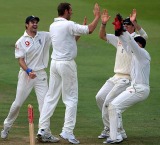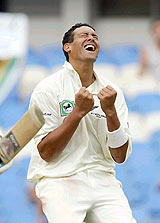Goliaths in awe of the Davids
India's big four are considered batting stars yet the bowlers who have been successful against them are the decade's half-forgotten names
24-Jul-2007
|
|

|
Cricket holds fewer mysteries than it used to, for several reasons. The commentators and their gizmos do a fine job of explaining it. One team can study another on their laptops. And they all meet more often than they once did. But some mysteries remain. Why does Geoffrey Boycott
keep telling you that what he is telling you is something he told you earlier? Why does no country pick a different team for the different game of Twenty20? And why do the Indian galacticos keep getting out to English greenhorns?
At Lord's, three of the big four fell in the first innings to Jimmy Anderson and one to Ryan Sidebottom. In the second, Rahul Dravid fell cheaply to Chris Tremlett (albeit unluckily, as the commentators and their gizmos soon showed), Sachin Tendulkar managed only one great shot,
and although Sourav Ganguly and VVS Laxman played their part in The Great Escape, neither was exactly MS Dhoni. England were missing their four first-choice seamers, yet India were bowled out for 201 in the first innings by the makeshift firm of Sidebottom, Anderson, and Tremlett, who sound more likely to draw up a man's will than to threaten his wicket.
Admittedly, the ball swung, and the bowlers controlled it well, in a way that Andrew Flintoff could have done with when he was trying to stop the flood of Aussie runs last winter. And you can't read too much into one match: the big names may well lord it in the next Test. But there is a pattern here. England have now done the same thing in four series running against India.
They have needed to, because every time they have been missing key bowlers. In 2001-02, Darren Gough and Andy Caddick both declined to tour for different reasons; they never did remotely resemble one another. Poor old Nasser Hussain was left with a new-ball attack of
Matthew Hoggard (playing his third Test) and the young Flintoff (looking for his eighth wicket), backed up by Craig White (as much a batsman as a bowler in India) and, for one match,
Jimmy Ormond (talented, but never given time to show it). Somehow Hussain made something out of this motley crew, and although England lost the first Test, they held their own in the other
two.
In 2002, Hussain was again missing Gough for the whole series, and Caddick for the first two Tests. The new ball was again taken by Hoggard and Flintoff, supported by White and a brand-new fourth seamer: Simon Jones, who showed some raw promise (partly with the bat).
This ragbag, plus Ashley Giles, somehow bowled India out for 221 on a flat Lord's pitch. England, awash with hundreds, set India 568 to win and bowled them out for 397. Ajit Agarkar made a hundred; the big four - or five, if you count Virender Sehwag - didn't.
For the rest of that series, the superstars reassserted themselves. Dravid made an immense hundred at Headingley, Tendulkar and Ganguly emulated him, Sehwag merrily blasted the shine off the new ball, only Laxman struggled, and India fought back to 1-1.
Back in India, this trend might have been expected to continue, although this time England's injuries were mainly to batsmen - their captain and vice-captain, Michael Vaughan and Marcus Trescothick.
Flintoff took over, and he began with a decent hand of seamers - Hoggard, Harmison and himself, but no Jones. With Hoggard putting his hand up, as the players say, the galacticos mostly flopped: India were kept in the first Test only by runs from Wasim Jaffer, Mohammad Kaif and Anil Kumble, with Dravid helping secure the draw in the second innings. A match of no hundreds at Mohali was won by two bowlers, Kumble and Munaf Patel - who showed that Englishmen too could be susceptible to a debutant.
The series was India's for the taking at Mumbai, even when England made 400. Flintoff was once again forced to take the new ball with Hoggard because Harmison was now injured. Anderson was drafted in as third seamer, and did so well (4 for 40) that he opened the bowling in the
second innings, when an unexpected combination of Flintoff, Anderson, Shaun Udal, and the late Johnny Cash shot India out for 100.
Hoggard finished the series with 13 wickets at 17. Tendulkar averaged 20, Sehwag 19, and Laxman, who played one Test, didn't get off the mark. Ganguly was out of favour and only Dravid, who averaged 61, was himself.
It's not just England who get away with pitting understudies against these titans. The bowlers who have done best against India this decade include half-forgotten names like Daryl Tuffey (21
wickets at 16) and Cameron Cuffy (28 at 28). Nor is it just seamers. Besides Udal, Michael Vaughan has flourished against India, taking 4 for 120, while managing 2 for 417 against everyone else. In 2001-02, Richard Dawson managed a Test four-for at Mohali. And once Michael Clarke of Australia took six-for with his occasional slow left-arm.
|
|

|
The Indian stars are sometimes accused of being grand, but in Tests against England it is only Ashley Giles (11 wickets at 50) who has incurred their disdain. With the exception of Dravid, they seem unable to dominate. It's as if they know they are Goliaths, so they freeze when any little David comes into view. Anderson, a pie-thrower against Australia, was transformed into a world-beater at Lord's.
In their last 11 Tests against India, England have fielded 13 front-line seamers, with only Hoggard and Flintoff making more than five appearances. In the first innings at Lord's, India's big names were not just unsuccessful but tentative. With the ball moving around corners, the game was there to be won by one attacking partnership. They couldn't produce it; Kevin Pietersen and Matt Prior did.
Individually, they have good-looking records against England since 2001. Dravid averages 65, Tendulkar 52, Ganguly 48, Sehwag and Laxman 32, so together they average 47. But given their class, and the bowlers' lack of it, that figure should be 57. Shane Warne never bothered these guys, but show them a journeyman county seamer and the galaxy falls to earth.
Do you think Indian batsmen are unable to dominate understudy bowlers? Tell us here
Tim de Lisle is a former editor of Wisden Cricketers' Almanack and author of the forthcoming Young Wisden (out in October). His website is www.timdelisle.com